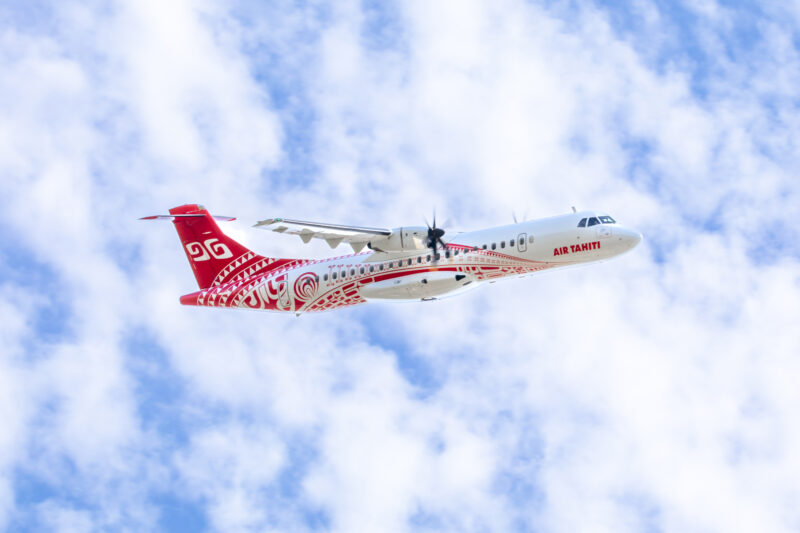Day three of the Farnborough Air Show has passed, so it’s time to dive into what headlines there are.
If any. It’s been a little dry, to put it mildly
As usual, we’ll be presenting this alphabetical order of the Civil Aircraft OEMs, followed by any other headlines that raise an eyebrow.
ATR Aircraft
Air Tahiti to add four ATR72-600 to its fleet
Air Tahiti has announced an order for four ATR 72-600 aircraft with Air Tahiti, along with an eight-year Global Maintenance Agreement (GMA).
Deliveries of the new aircraft are scheduled between 2025 and 2028.
The new aircraft will significantly improve regional connectivity in the region. By linking communities, they will stimulate economic growth through increased business activity, tourism, and investment opportunities.
Edouard Wong Fat, Air Tahiti’s Chief Executive Officer, said:
“Air Tahiti has been a cornerstone in Tahiti and its islands for more than 65 years, facilitating not just travel but a better quality of life. By ensuring our communities have easy access to essential goods, services, and cultural experiences, we’ve also helped boost the local economy and tourism. The ATR fleet has been pivotal in these efforts and it will continue to enable us to offer reliable and responsible connectivity.”
Nathalie Tarnaud Laude, ATR’s Chief Executive Officer, added:
“Air Tahiti’s continued trust, earned over many years, is a testament to our commitment to providing the most efficient, comfortable, and low-emission regional aircraft. In French Polynesia, where air services are particularly vital, our aircraft, emitting 45% less CO2 compared to similar-size regional jets, are ideal for responsible travel. This region, with the shortest and one of the longest ATR flights between islands, highlights the importance of our mission. At ATR, we focus on supporting affordable regional mobility while aligning with sustainability goals.”
Embraer
Embraer has announced upgrades to the E195-E2, E190-E2, and E175, including fuel burn and range improvements, avionics and cabin upgrades.
In total, an upgrade could save over US$ 6 million per aircraft over 15 years in cost reduction and additional revenue.
The E175 gets a retrofit, with:
- Larger overhead bins, with “wheels first” loading and mood lighting
- Multi-band satellite connectivity, with Ka and Ku Connectivity as options
- Recaro Seating
- Next-generation weather and data avionics
Meanwhile, on the E2 platform, there will be upgrades, including:
- Fuel burn – with a reduction of 2.5%
- Improved range, with the range on the E195-E2, has been boosted to 3000NN, with a new Max Take Off Weight of 62,500kg
- Geared Turbo Fan time on wing improved – with improvements up as 10%
- Enhanced take-off system – This automatic take-off system produces a more precise and efficient rotation moment and flight trajectory, reducing the required field length and pilot workload; meaning more payload and more range from challenging airports. This gives the E2 good performance in airports such as London City, Florence, and Santos Dumont, with it adding up 350NM of range from City for example.
- Cabin optimisation – For those who love a dense cabin, the E195-E2 can be “optimised” for four extra seats – taking it from 136 seats to 140.
Arjan Meijer, President and CEO, Embraer Commercial Aviation, said,
“We aim to continually improve our aircraft and these upgrades announced today – reducing fuel burn and emissions; increasing range; improving the passenger and cabin experience; and adding new technology and connectivity – is great news both for our customers and their guests. Embraer is committed to providing the safest, most efficient, most comfortable, and most commercially savvy jets to our customers.”
Other headlines
Airbus has announced a new partnership with aircraft lessor, Avolon, to study the potential of hydrogen-powered aircraft, marking the very first collaboration of the ZEROe Project with an operating lessor.
They’re hedging their bets, with Airbus investing in LanzaJet, a sustainable fuels technology company and producer, in line with its ambition to act as a catalyst for the global development of sustainable aviation fuels (SAF).
GE Aerospace Engines have been busy, pulling in orders, notably:
- Japan Airlines selected GEnx for their new 787s (20 Aircraft/40 engines)
- British Airways turning away from Rolls Royce and selecting GE for six new Boeing 787 aircraft (12 GEnx engines)
- American Airlines signing for CF34 engines to power 90 Embraer E-175 (180 engines)
- Nordic Aviation Capital selects the LEAP-1A for its A321neo aircraft (5 Aircraft/10 engines + 2 options).
- Avolon signs for 150 LEAP-1A engines to power 75 aircraft
- Macquarie AirFinance Signs Agreement for 40 LEAP-1B Engines (20 aircraft)
- EVA Orders GEnx Engines to Power Boeing 787 Fleet Expansion (4 aircraft/8 engines)
GE Aerospace announced that following EVA Air’s recent deal to purchase four Boeing 787-10 Dreamliner aircraft, the airline has placed an order for GEnx engines to power their new aircraft.
It’s been a quiet show so far
With Farnborough 2024 heading into the final day, we can hope for some excitement. Otherwise, it’s been a very quiet show so far, with under 200 orders and commitments logged so far – with none of the big lessors choosing to add masses to their fleets.
Hopefully, the big OEMs will have something to show for their efforts. Otherwise, there could well be a slow trickle of orders post-show as agreements are finalised.
Welcome to Economy Class and Beyond. Your no-nonsense guide to network news, honest reviews, in-depth coverage, unique research, as well as the humour and madness I only know how to deliver.
Our Social Media pool has expanded. You can find us across most networks as @economybeyond on Twitter, Mastodon, BlueSky, Threads and Instagram!
Also, remember that we are part of the BoardingArea community, bringing you the latest frequent flyer news from around the world.

